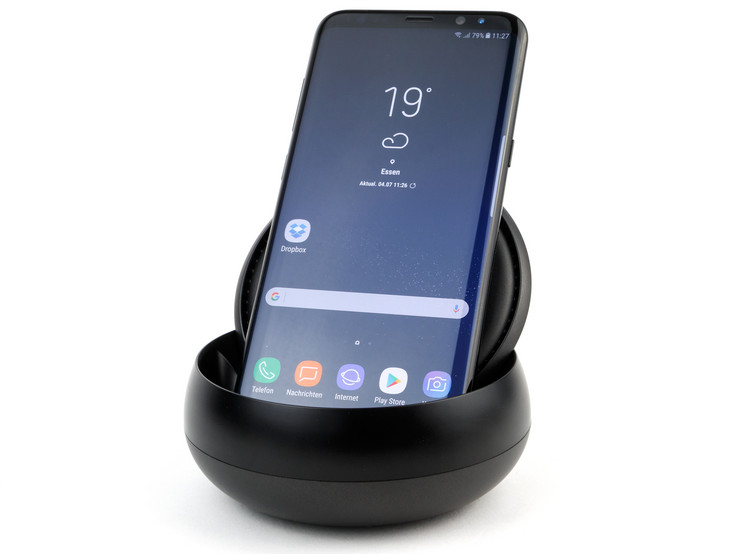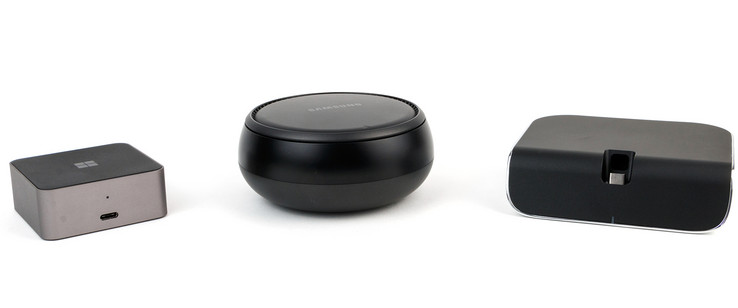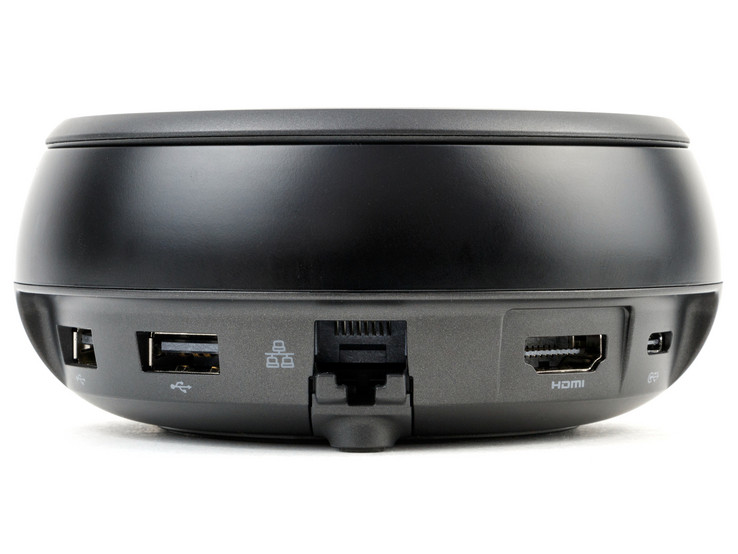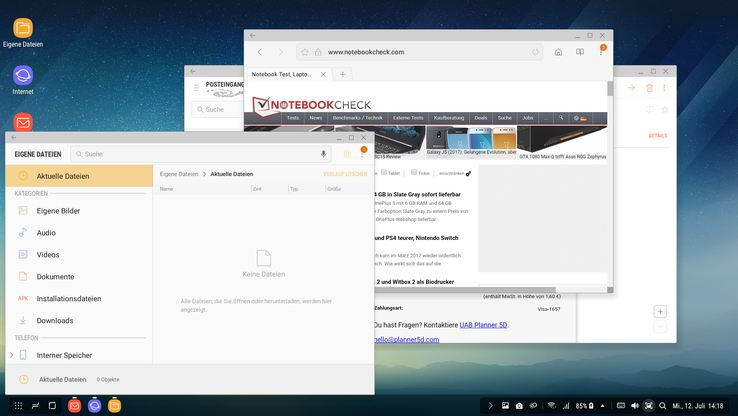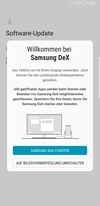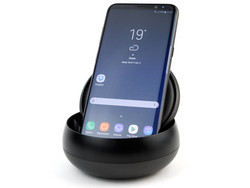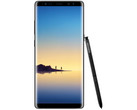Samsung DeX MG950TBEGUS Docking Station Review
For the original German review, see here.
Samsung aims to increase the productivity of its Galaxy S8 and Galaxy S8+ flagship models with the DeX station. It closely follows the concept of Microsoft's Continuum that is, however, based on Windows 10 Mobile. However, Samsung relies on a Google Android desktop version.
Starting up is quite simple. Samsung's DeX only needs an outlet, an HDMI cable that is connected to an external monitor, a mouse, and a keyboard. Then, the Galaxy smartphone has to be inserted and the user is ready to go. Not only does this sound easy, it is easy. In this review find out why we can only give the DeX station a conditional purchase recommendation.
Case
With a weight of 232 grams (~8.2 oz) Samsung's DeX station is comparatively light. The more compact Microsoft station weighs only 229 grams (~8.1 oz), but it is also much smaller and makes a higher-quality impression with its metal casing. HP's model is the heaviest model in the comparison field with 449 grams (~15.8 oz).
The DeX's plastic casing does not look or feel very attractive, and it does not really reflect the high RRP of 149 Euros (~$150). Nevertheless, it is well built and does not give any real cause for criticism. Furthermore, the rubberized underside prevents the docking station from slipping off a table.
Inserting the smartphone is a bit awkward since the slot is slightly wider and there is no guidance. The modular design of HP's station in particular solves this much better.
Connectivity
The connectivity of Samsung's DeX docking station is similar to that of the Windows 10 Mobile rival models. It offers a USB Type-C port that is responsible for power supply and two further Type-A ports that support the 2.0 transfer standard. Peripherals or storage devices can be connected to them. An HDMI port takes care of video output. The system can also be connected to a cabled network, but the Ethernet interface only supports 100 MBit/s.
Unfortunately, the included accessories are sparse. The box contains only the docking station and a multilingual quick start guide. A matching power supply is not included and has to be bought separately or that of the Galaxy S8 can be used. Samsung recommends its own power supplies (9 V/1.67 A, 9 V/2 A, 12 V/2.1 A) for trouble-free use. To maintain the smartphone's quick charge feature, an optional charging adapter (12 V/2.1A) has to be purchased. However, Samsung did not offer this at the time of testing.
The video output of Samsung's DeX docking station is limited to 1920x1080 pixels. Contents are scaled accordingly when higher resolution screens are used. Thus, the monitor is completely filled and this can cause delays with 21:9 screens. The image can be adapted, but it then has wide borders.
Software
Samsung's DeX basically functions like Microsoft's Continuum and displays the user interface of a mobile operating system in a desktop version. In this case, it is Google Android 7. Samsung has managed to copy the looks very well. The desktop makes a clearly arranged impression and responds very quickly to inputs. Using a mouse and keyboard also functions very well. It is a pity that the Galaxy smartphone cannot be used as a touchpad.
All apps can be opened and used on the screen since Google's Play Store is fully integrated. However, it is quickly seen which applications have been modified for DeX and which ones have not. Thus, streaming apps such as Netflix or Sky Ticket can be launched and used, but only in a minimized window and not in full-screen mode. This makes Samsung's DeX virtually useless as a smart TV replacement. Multitasking functions well and very smoothly. It is no problem to have multiple apps opened in adjacent windows. However, inactive apps are stopped so that it is not possible to browse the Internet and stream a favorite series at the same time, for example.
It is actually convenient that all messages are also directly displayed on the desktop. This is also true for incoming calls, but the user is then faced with a real challenge if a Bluetooth headset is not at hand.
Samsung's DeX also supports remote access on virtual Windows computers via VDI solutions (virtual desktop infrastructure), such as Citrix Receiver VMware Horizon Client and Amazon Workspaces, which require purchasing separate licenses.
Unfortunately, using Samsung's DeX is restricted to the Galaxy S8 and Galaxy S8+ for the moment. Even the Galaxy Tab S3 that comes with the required hardware and power does not offer this feature. The DeX docking station can also be used with Continuum smartphones, which then use Windows 10 Mobile and have full access to DeX's interfaces. This does not work the other way around. A Galaxy S8+ connected to the Microsoft Continuum station only reproduces the screen on the external monitor - a real pity.
Emissions
We used Samsung's DeX station with the power supply of a Galaxy S8+. We could not detect high surface temperatures. The standby rate was just 0.2 degrees higher than the ambient temperature, and the DeX station did not heat up to more than 31 °C (~88 °F) when in use.
On the other hand, the power consumption was surprisingly high and fluctuated from 0.65 to 0.75 watts when nothing is connected. This adds up to approximately 1.84 Euros (~$1.15) per annum (calculation base: 0.30 cents/kWh) just for having it available.
The DeX station also has an integrated fan. It remains inactive during normal desktop mode without more demanding apps. However, it speeds up quite quickly during medium load and then varies its frequency range from 16 to 2000 Hz at around 50 dB(A), which is quite audible. The fan gets even louder during permanent load and reaches up to 56 dB(A). This is definitely too loud for a device that is actually cooled passively.
Verdict
Samsung's DeX EE-MG950 docking station is a very exciting product that is primarily suitable for private users who want to simply organize their emails on a bigger screen or take care of some image editing. Using it in a corporate environment would also be possible, but the Windows solutions, particularly HP's Elite x3, are better configured and more sophisticated in this field. This is not least because the Windows devices maintain their full functionality, even when they are in docking mode.
Samsung's DeX is an important step toward replacing the desktop PC. But it is, however, just a first step rather than the final step.
It is annoying that there are so few accessories included with the DeX docking station. We would have at least expected a power supply that is strong enough to implement the quick charge feature of the Galaxy S8 smartphones. The fan installed in the docking station is not comprehensible either. It is unnecessarily loud, and is already very audible during medium load. Despite some minor flaws, the user interface is appealing during multitasking and makes a well-conceived impression. Furthermore, it still looks very attractive on Ultra HD screens, although it is only designed for 1080p.
Samsung's DeX docking station is a successful first attempt by the Korean manufacturer that, however, still has some room for improvement. We find its RRP of 149 Euros (~ $150.00) quite high, but its current market price has already dropped to below 100 Euros ($ 100.00), which makes it worth considering.


